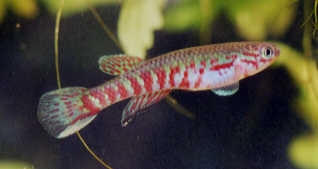

| Meaning of Name |
After the spotted, mottled patterning on the body. |
|||||||||||||||
| First Description |
Radda A.C. & Pürzl E. 1977. Cyprinodontiden Studien in Gabun II. Nordgabon. Aquaria 24: p 27-29, figure 7. |
|||||||||||||||
| Size |
4.5 cm |
|||||||||||||||
| Meristics |
|
|||||||||||||||
| Karyotype |
n = 17, A = 22 (Scheel 1990) |
|||||||||||||||
| Sub-Genus |
Mesoaphyosemion |
|||||||||||||||
| Group |
cameronense |
|||||||||||||||
| Synonyms |
None |
|||||||||||||||
Populations
|
Ebé - A location mentioned in Wildekamp's 1981 book. Found near the village of Ebé in the rainforest. This may refer to Jan Pap's collection in 1980. GAB 19/90 - On the Koumaméyong to Ovan road. This location is thought to be the type locality. GBG 92/23 - Fished in July 1992 by Grell & Bitter in a stream crossing the Lalara to Koumaméyong road in the village of Matora. Also found was D.georgiae. GBHL 86/18 - 14kms west of Ovan on the road to Koumaméyong. Collected in February 1986. Also collected were A.punctatum, D.georgiae & E.neumanni. This collection was returned alive to Europe but did not last long. LEC 93 / 4 - Near Ebé, 12kms from
Ovan on the road to Koumaméyong. Also fished what the villagers
considered Pap's collecting place G80 some 400 metres west of the end
of the village. A.maculatum, large
numbers of barbs, characin, tadpoles, shrimps & water insects.
PEG 93/14 - Matora, 18kms west of the crossroads in Koumaméyong. The villagers took Passaro & Eberl to a stream north of the village where A.maculatum could be caught in large numbers. D.georgiae was also there but in small numbers. PEG 94/13 - Stream 15kms west of the bridge in Ovan, near the village of Messé which crosses the road. A.maculatum & D.georgiae were found but not returned to Europe. PEG 94/14 - 18kms west of the bridge in Ovan. The Messé stream crosses the road between Messé & Mélané. This collection was brought back alive to Europe & distributed. PEG 94/17 - Lolo 1·47km Eeast of Lalara. |
|||||||||||||||
| Type Locality |
Marshy ground in rainforest 33 km east of Koumameyong
& 20 km west of Ovan in northern Gabon. Collected on the 11th December
1975 at 16.20 hrs. |
|||||||||||||||
| Distribution |
Small area in northern Gabon, in the Okano River
drainage system between Koumameyong & Lalara. This area is on the
inland plateau. |
|||||||||||||||
| Habitat |
Small rainforest streams & brooks. |
|||||||||||||||
| Distinguishing Characteristics | Heavy wide red markings in the rear of the body. This pattern is probably only confused with A.mimbon. Fins however are totally different with wide yellow outer margins in A.mimbon. A.maculatum is blue (east of Koumaméyong) & yellow phase (west of Koumaméyong) depending on population with a lot of red patterning. | |||||||||||||||
| Colour/Pattern Variability | Usually variable in the amount of red markings in the rear of the body. | |||||||||||||||
| History |
Discovered in 1977 in a marshy area near the road (N4) from Koumaméyong & Ovan (33km east of Koumaméyong & 20 km west of Ovan). The collected fish were all males so obviously no distribution was possible. Jan Pap collected near Ebé to the west of Ovan. I am not sure as to the date or code for this collection. It may be JP 80 but I have little information on this code). This collection did not last long in the hobby. In February 1986 Bardin, Lombard & Houdu (GBHL 86) collected the species at location 18 but failed to distribute to the hobby. In 1990 Alan & Barbara Brown with David Armitage
collected from the type locality. This collection was coded GAB 19/90
(also seen as GAB BBA 19/90). These fish were brought back to the UK
& bred. In July 1992 Grell collected & brought back the species on the road from Matora between Lalara & Koumaméyong. It reportedly had 'striking yellow fins'. In January 1993 Legros, Eberl & Cerfontaine collected them from LEC 93/3. These were brought back to Europe & distributed. In July 1993 Passaro & Eberl collected them at PEG 93/14 near Matora. Reportedly has 'yellow fins'. In 1994 Passaro & Eberl again collected. This time in several localities including a stream west of Ebé & in the village of Lolo I (PEG 94/17). |
|||||||||||||||
| Breeding Notes |
Regarded as a difficult species to breed. I have bred them in 100% rainwater. Eggs, although not numerous were found regularly. The parents are regarded as non aggressive to fry. I did raise one fish up to about 1.5 cm. There might have been more but I collected the eggs from the mops. This one was probably laid in the plant cover. Other reports suggest a water incubation time of 15-20 days with slow growth noted. Sexual maturity takes about 8 months. Jan Pap reported that females outgrew males & would kill them. Jaroslav Kadlec in BKA Newsletter No.380 May
1997 reported breeding them in water without carbonate hardness. Total
hardness 1 - 5° with a pH of 5·5 - 6·5. It was found
that 50%+ of eggs produced were unfertilised or disintegrated after
a few days. If the water chemistry was not kept as previously mentioned
all eggs would disintegrate. If levels were kept within these parameters
about 25% of eggs produced would hatch. |
|||||||||||||||
| Diameter of Egg | ||||||||||||||||
| Remarks |
It has been noted that young fish are sensitive to sudden water changes. Also, they are sensitive to a build up of waste matter in the water. This species seems to require regular very small water changes. I have kept 2 pairs in seperate tanks for 6 months without changing the water & they were full of life with the odd youngster in there as well. The tanks were heavily planted with Ceratopteris hence the removal of nitrate from the water. |